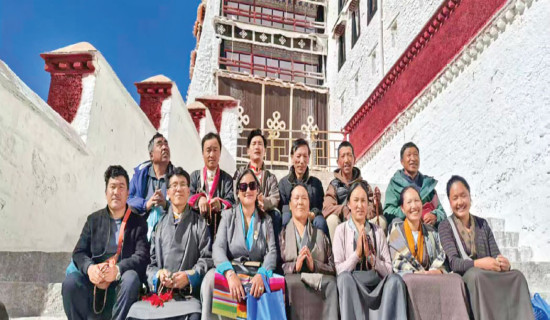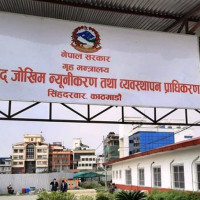- Saturday, 22 November 2025
COP29 and Nepal: Climate Action and Sustainable Development
Irshad Ali Shekh 
COP29 will be held in Baku, Azerbaijan, from November 11–22, 2024 and will focus on increasing climate finance for developing countries. Azerbaijan's economy relies heavily on fossil fuels, contributing 90% of its export revenue and 60% of government income, according to the International Energy Agency (IEA). As host, Azerbaijan faces both an opportunity and a challenge: it can either demonstrate leadership by committing to a fossil fuel phase-out or offer compensation mechanisms to support global climate goals.
The COP29 is going to focus more on the issue of ‘climate finance’ therefore it also called ‘Finance Coop’ as the topics of ‘Climate Finance’ and ‘Carbon Credit’ are among the most primary topics of discussion.
What is COP
The ‘Conference of the Parties’ or ‘COP’ is an annual event that brings together the governments which have signed up for environmental action under the United Nations (UN). The UN Climate Change Conferences (COPs) have been held annually since COP1 in 1995, with the exception of 2020 due to the COVID-19 pandemic. Attendees represent diverse groups, including government officials, civil society, private sector actors, Indigenous communities, and humanitarian organizations.
Humanitarian actors have increasingly participated in COPs to spotlight how climate change exacerbates humanitarian crises. Vulnerable populations, those least responsible for global warming, suffer the most from climate-related disasters.
At COP28, a significant step was taken with the introduction of the “Relief, Recovery, and Peace” thematic day and the non-binding COP28 Declaration. This declaration calls for urgent climate finance and actions to support communities affected by fragility and conflict. The inclusion of humanitarian issues within the official COP agenda reflects growing recognition of the need for proactive, preventive measures to reduce humanitarian risks caused by climate change.
Mission 1.5°C
COP28, held in Dubai in 2023, was the first of three consecutive climate conferences aimed at "resetting" global climate action. This initiative aligns with the UN’s 'Roadmap to Mission 1.5°C'—an urgent call to limit global temperature rise to 1.5°C above pre-industrial levels. This threshold, central to the Paris Agreement, is widely seen as the maximum acceptable limit to avoid severe climate impacts, including extreme weather, sea-level rise, and ecosystem collapse. This mission emphasizes urgent, collective action by governments, businesses, and civil society to transition toward renewable energy, phase out fossil fuels, and implement sustainable practices.
Nepal, the fourth most vulnerable country to climate change globally, has made significant progress in forest conservation, creating promising opportunities for carbon trading. Forests now cover 44.74% of Nepal’s land area, up from 39.99% in 2000. Although it contributes only 0.027% to global greenhouse gas emissions, Nepal faces severe climate risks. In response, Nepal has ratified the Paris Agreement and adopted climate policies focused on limiting global temperature increases, with a goal of achieving net-zero emissions by 2045.
Access to Climate Finance for Adaptation and Resilience
At COP16 in 2010, developed countries pledged $100 billion annually by 2020 to support developing nations in climate action, a largely symbolic goal for 2020-2025. This year, Nepal earned $35.27 million through carbon trading. Nepal is now set to sign a new carbon trading agreement at COP29 in Baku. Through the LEAF (Linking Environment and Farming) Partnership, Nepal plans to sell carbon stored in its forests, with a goal of cut off 7 million tons of carbon and generating $100 million by 2028. However, achieving the financial benefits requires halting forest degradation and enhancing carbon reserves through protection efforts.
Nepal’s climate targets require substantial financing: $33 billion for its Nationally Determined Contributions (NDCs) from 2021 to 2030, $47.4 billion for the National Adaptation Plan (NAP) by 2050, and $196 billion to achieve net-zero emissions by 2045. Since public funding alone is inadequate, Nepal must secure international climate finance and increase private-sector investment.
As global temperatures rise, Nepal faces escalating climate-related disasters. Events such as massive flood and landslide in September, an August glacial lake outburst flood in the Everest region, widespread forest fires in early 2024, the 2023 Kagbeni flood, the Darchula flood and landslide in 2022, and the 2021 Melamchi flood, clearly highlight the increasing frequency and severity of these impacts. Looking ahead to COP29, humanitarian organizations are advocating for deeper integration of climate strategies with disaster preparedness.
Investing forest-based carbon trading revenue in disaster anticipatory action and early warning systems (EWS) could strengthen Nepal’s climate resilience. Priorities could include expanding EWS with advanced sensors, supporting community EWS initiatives, training locals in preparedness, and establishing Forecast-Based Financing (FbF) for resource mobilization. Funds could also enhance remote communication for alerts, develop predictive models, and support resilient infrastructure and ecosystem-based solutions like reforestation. Additional investments in public awareness, insurance for high-risk areas, and financial recovery would further reduce vulnerability, stabilize forests, and sustain carbon market gains.
Projections suggest that by 2050, Nepal could face a 2.2% GDP loss, and up to 200 million people worldwide may be pushed into poverty due to climate-related disasters. This highlights the urgent need to shift from reactive responses to proactive, anticipatory strategies.
Advancing Carbon Trading Initiatives
Nepal has begun integrating climate finance into its fiscal policy and budget planning by investing in renewable energy technologies, including solar and wind installations, electric cookstove deployment, the construction of domestic biogas plants, and solar photovoltaic pumping systems.
Nepal’s involvement in international carbon markets could generate essential revenue, which can be reinvested in forest management, community development, and climate adaptation projects. The country has already seen some success in carbon trading and looks forward to additional benefits from carbon credit sales. COP29 represents a crucial opportunity for Nepal to advocate for fair carbon pricing, promote transparent and equitable market mechanisms, and establish bilateral or multilateral agreements for future carbon sales.
Capacity Building and Technical Assistance for Anticipatory Action
Nepal’s unique geographical and environmental conditions make it highly susceptible to climate-induced disasters, including floods, landslides, Heatwave, Cold wave and glacial lake outburst floods (GLOFs). COP29’s focus on capacity building and technical assistance provides Nepal with an opportunity to secure resources in anticipatory action in disaster management. By collaborating with international partners and drawing on technological advancements, Nepal can strengthen its disaster preparedness and response capabilities.
Anticipatory action refers to actions taken to reduce the humanitarian impacts of a forecast hazard before it occurs, by providing a structured approach to reducing the impact of disasters. It enables a coordinated, proactive response based on forecasts or predictive analyses to mitigate potential effects before they become severe.
Improving disaster management system could drastically reduce the economic and human loss of climate disasters in Nepal. These systems could also support sustainable livelihoods, as farmers and local communities can adapt agricultural practices based on timely weather forecasts. This would contribute not only to Nepal’s resilience but also to the nation’s economic stability and growth.
Opportunities for Renewable Energy Expansion
Clean energy transitions are set to be a central focus at the climate conference, highlighting renewable energy sources, energy efficiency, and green technologies. For Nepal, with its rich hydropower potential, this is a prime opportunity to boost hydroelectric exports to major CO2 emitters, including China (32.88% of global emissions), India (6.99%), Bangladesh (0.47%), and other neighbors. There’s also strong growth potential in solar and wind energy, which would enhance energy security, support electric vehicle adoption, and increase electricity use in Nepalese households.
Expanding clean energy could reduce Nepal’s dependence on imported fossil fuels, foster job creation, and stimulate economic growth. Additionally, COP29 offers Nepal a strategic platform to promote cross-border energy trade and position itself as a key renewable energy exporter in South Asia.
Strengthening Community-Based Adaptation
A significant opportunity at COP29 for Nepal lies in promoting community-based adaptation (CBA), which involves empowering local communities to lead and participate in climate adaptation efforts. Given that many of Nepal’s rural communities depend on agriculture and forest resources for their livelihoods, CBA approaches are particularly relevant. With climate finance dedicated to CBA, Nepal could implement projects focused on sustainable land management, water conservation, and agroforestry that directly benefit communities most affected by climate change.
This would support rural development and help Nepal’s vulnerable communities build resilience from the ground up, creating a sustainable pathway for both climate adaptation and poverty reduction.
Conclusion
For Nepal, COP29 presents an invaluable opportunity to deepen its involvement in the global climate agenda, securing financial, technical, and capacity-building support necessary for sustainable development. By proactively engaging in climate finance, carbon trading, renewable energy expansion, and community-based adaptation, Nepal can turn the challenges of climate change into drivers of economic growth and resilience. As Nepal steps onto the global stage at COP29, it has the chance not only to secure resources to protect its people and environment but also to emerge as a leader in sustainable mountain development and climate resilience, inspiring other vulnerable nations in the process.
(Shekh has over 14 years of working experience in development, international relations and disaster risk management.)











-original-thumb.jpg)




